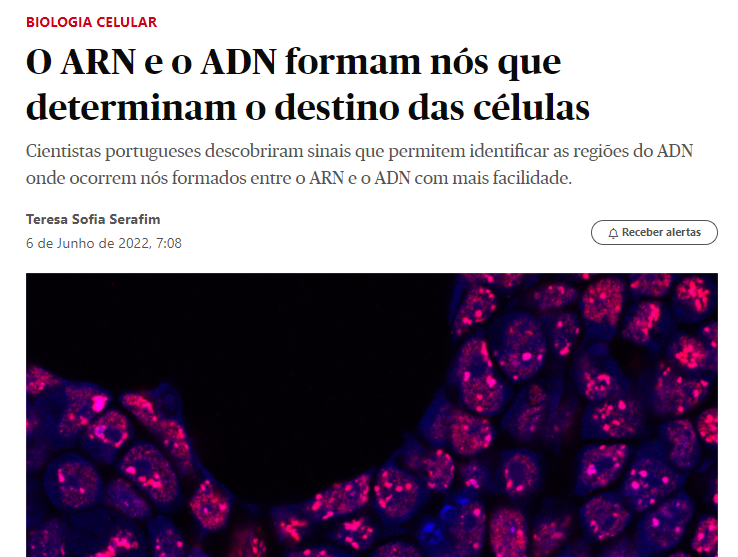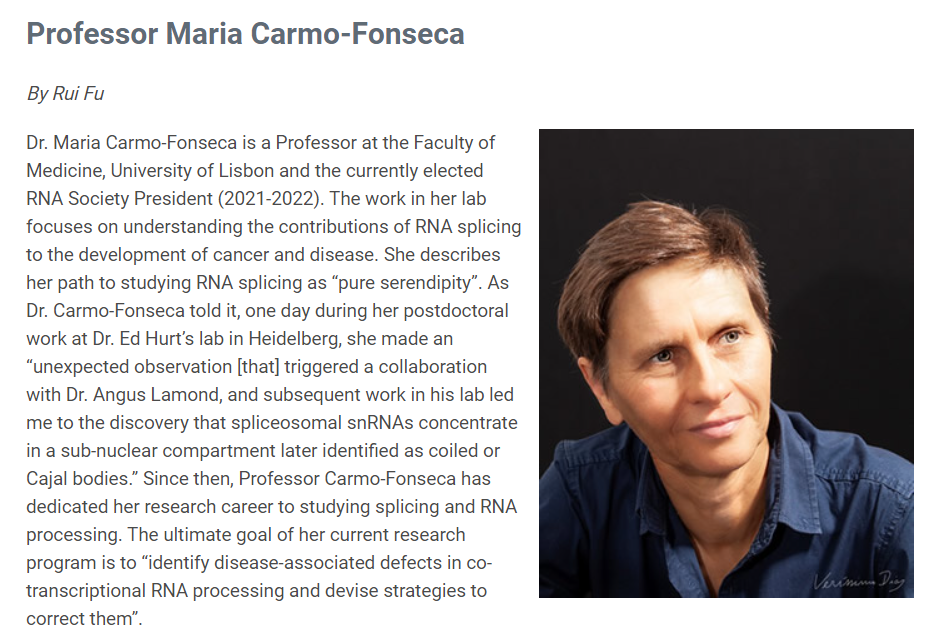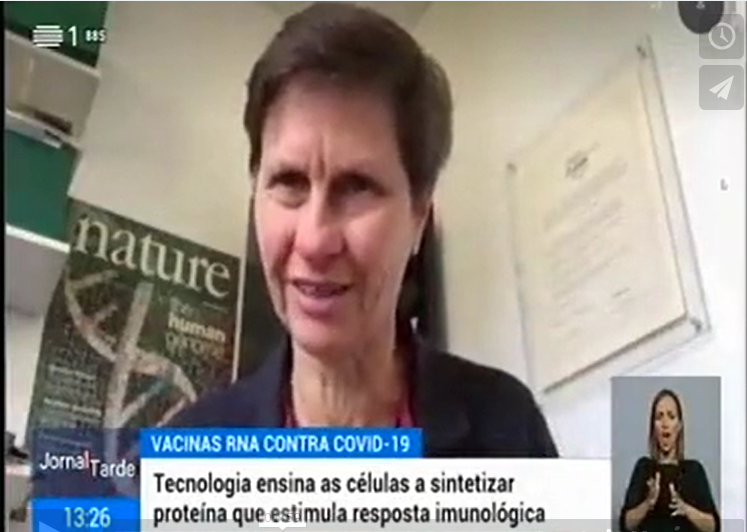Know more about RNA Biology and the work developed by the RiboMed scientists at Instituto de Medicina Molecular João Lobo Antunes (iMM).
Visão | Cancro - A corrida pelas vacinas
October 13, 2022
Read here (Portuguese only).
RTP3 | Grande Entrevista
August 17, 2022
Watch here (Portuguese only).
Público | "O ARN e o ADN formam nós que determinam o destino das células"
June 6, 2022
Read here (Portuguese only).
Expresso | "Cientistas portugueses realçam importância de primeiro genoma humano completo"
March 31, 2022
Read here (Portuguese only).
Expresso | "mRNA, a arma que está a revolucionar a saúde"
February 28, 2022
Read here (Portuguese only).
Público | "Estamos a entrar na era dos medicamentos de ARN e ADN"
November 2, 2021
Read here the interview with Melissa Moore, member of RiboMed Advisory Board (Portuguese only).
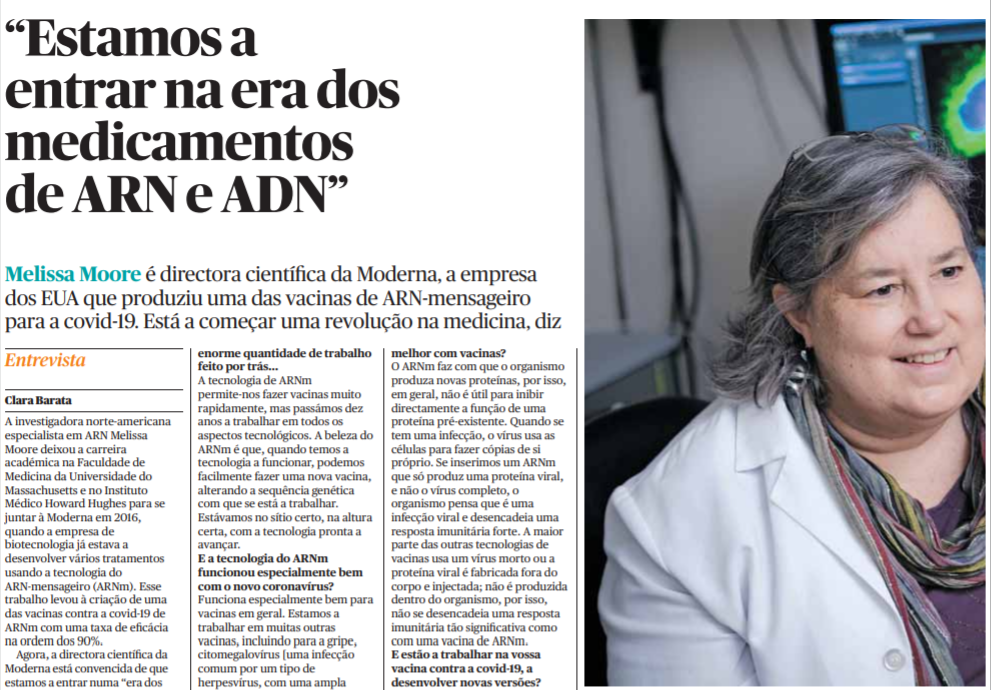
RNA Society | Member Spotlight: Professor Maria Carmo-Fonseca by Rui Flu
October 2021
Read here.
SAPO24 | mRNA: Dos bastidores ao palco principal do combate à pandemia. As vacinas contra a COVID-19 são só a ponta do iceberg
August 2, 2021
Read here (Portuguese only).
RTP1 - Jornal da Tarde | RNA Vaccines
July 3, 2021
Watch here (Portuguese only).
Observador | Found technology that can help understand diseases
June 16, 2021
Instituto de Medicina Molecular and Oxford University develop a mechanism to better understand DNA and RNA. Certain diseases can occur due to defects between these two chains.
Read more here (Portuguese only).
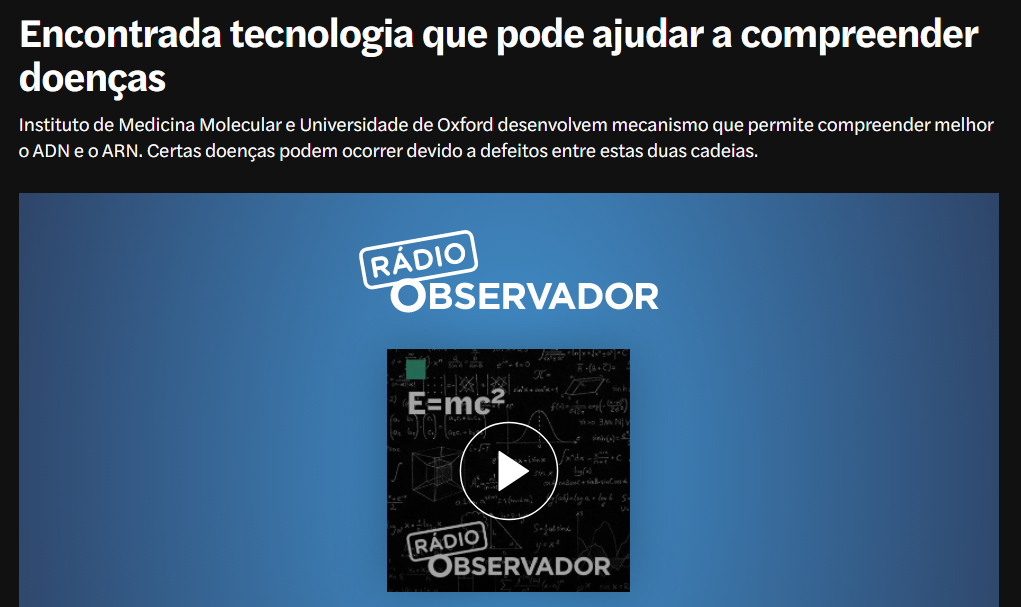
Público | Portuguese help create a new technique that deciphers the speech of our cells
June 14, 2021
A team with scientists from the Instituto de Medicina Molecular has developed a new technology to understand the dynamics of RNA and which can help in the understanding of certain diseases.
Read more here (Portuguese only).
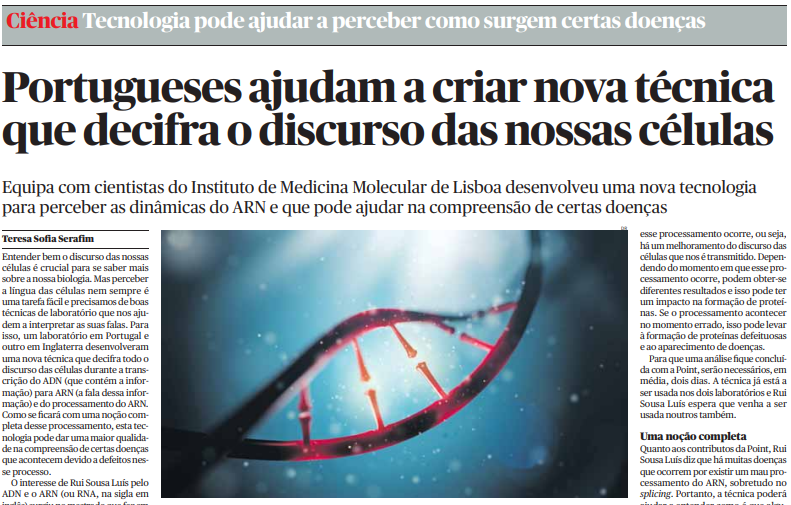
SIC - Admirável Mundo Novo | RNA – a new era in cancer treatment and new way to revert ageing
December 28, 2020
Maria-Carmo Fonseca, RiboMed coordinator, iMM President and Group leader, and RNA Society President, nominate RNA molecule as the most important scientific event of 2020: because of the SARS-CoV virus for sure, but mainly because of the new RNA vaccines and for the Nobel Prize in Chemistry awarded to CRIPSR technology.
Maria-Carmo Fonseca also emphasizes the important of Science and the joint efforts of scientist through this year to fight COVID-19 pandemic that culminate in the vaccine in less than a year. The principles applied to the SARS-CoV-2 vaccine can be used in cancer treatments.
Read more here (Portuguese only).

Visão | mRNA, the Theraphy of the Future
November 19, 2020
Over the last few weeks promising data on SARS-COV-2 vaccines efficacy were publicized. Some of those vaccines are innovative and based on mensager RNA (mRNA).
The journalists Mariana Almeida Nogueira e Vânia Maia wrote in Revista Visão a piece that explain the importance of the approval of first vaccines based on mRNA.
One of the personalities interviewed in that work in Maria-Carmo Fonseca, president of the Instituto de Medicina Molecular and RNA Society and RiboMed coordinator. Maria-Carmo Fonseca emphasizes the important moment we are all living and the potential therapies based on RNA. The researcher highlights also that the team that coordinates “is focused on cardiac diseases with genetic causes that can lead to sudden dead, and that can be corrected by RNA. Almost all the genetic diseases drove from damaged original information that pass from DNA to RNA; however, now is possible to correct those mistakes at RNA level, without need to alter the DNA.”
Read more here (Portuguese only).
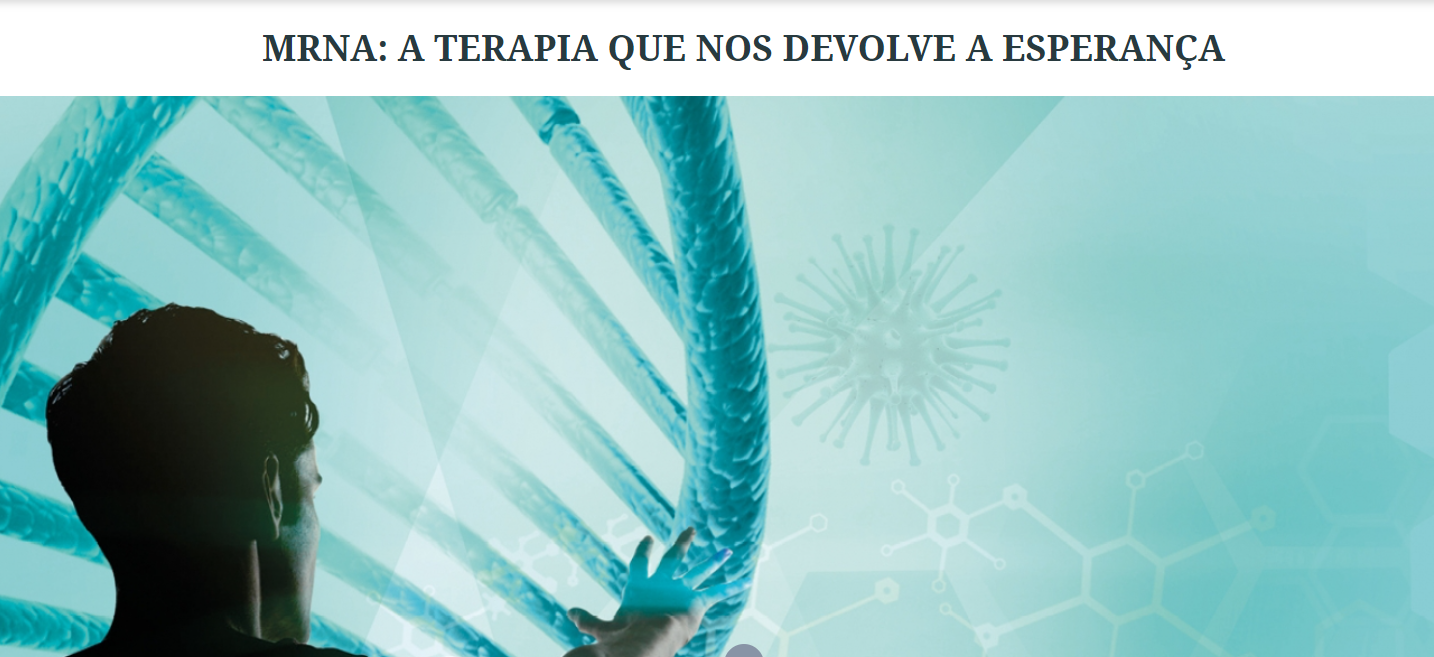
Exame Informática | Maria-Carmo Fonseca election as President of The RNA Society
September 1, 2020
On May 2020, Maria-Carmo Fonseca, RiboMed coordinator and President of Instituto de Medicina Molecular, was elected the new President of The RNA Society.
The RNA Society is an international scientific society dedicated to fostering research and education in the field of RNA science. This Society, with more than 1800 members, is a community of scientists passionate about better understanding the fascinating world of RNA biology.
Read more here (Portuguese only).


Academia das Ciências Médicas de Lisboa
March 3, 2022
"RNA in medicine"
On 3rd March 2022 Maria-Carmo Fonseca, RiboMed coordinator, and iMM principal researcher, discussed the RNA in medicine at the Academia das Ciências Médicas de Lisboa.
"In the early 1950s, the discovery of the DNA double helix triggered the rapid development of an emerging scientific area termed Molecular Biology. Since the birth of recombinant DNA technology, the science of Biology and Genetics changed from studying “Life as we know it”, to “Life as we make it”. With the turn of the millennium, a new revolution in the Life Sciences started to take shape and at the beginning of the 2020s, the potential impact of RNA molecules in medicine is huge. From RNA interference therapies, to mRNA vaccines and CRISPR-mediated genome editing, my conference will focus on the brave new world of medical applications of RNA."

International Nucleome Consortium Webinar
July 17, 2020
"The challenge of measuring splicing kinetics" by M. Carmo-Fonseca
New Frontiers in Cardiomyopathies. Cardiomyopathies in clinical practice. International Post-Graduate Learning Course.
November 28-29, 2019
The "New Frontiers in Cardiomyopathies – Cardiomyopathies in clinical practice" was a live educational event directed by Dulce Brito, MD, Ph.D and Fausto J. Pinto, MD, Ph.D in Lisbon School of Medicine, Universidade de Lisboa, Portugal. This course aimed to provide up-to-date knowledge of cardiomyopathies regarding the mechanisms involved in their development and progression, how to diagnose and manage, how to choose the best candidates for new or specific therapies.
In this course, Maria-Carmo Fonseca, RiboMed coordinator, and iMM principal researcher, discussed development of gene therapy approaches and presented results from the research group on cardiomyopathies in the seminar “Sarcomeric cardiomyopathies: pathways from bench to bedside”.
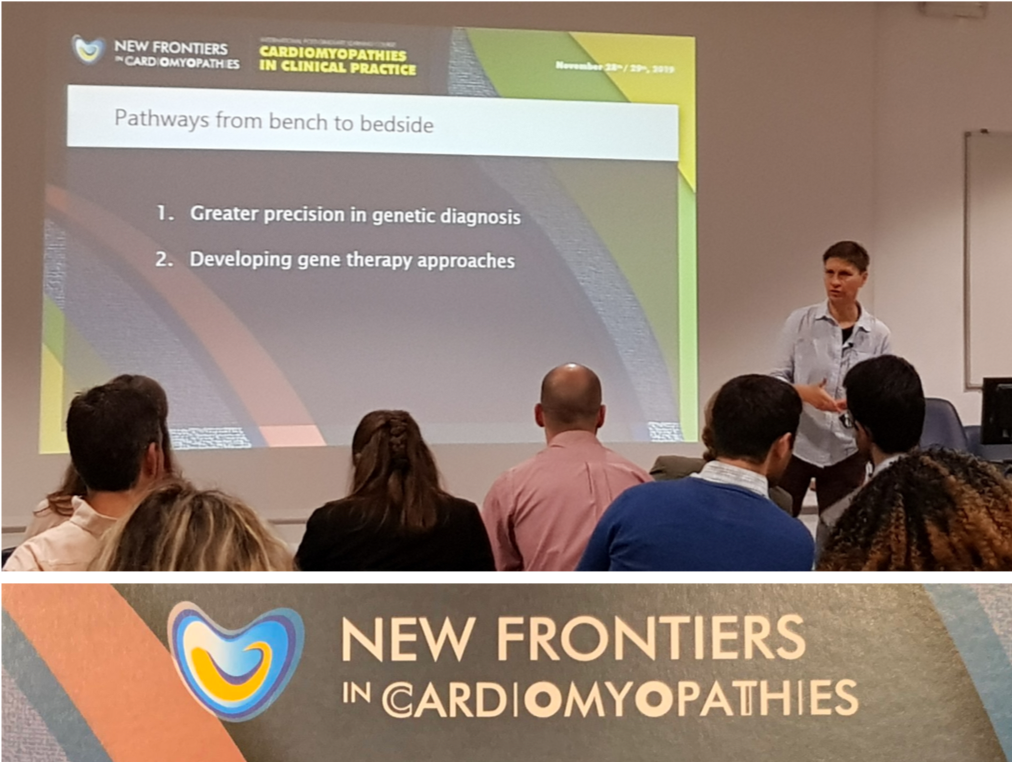
Targeting RNA
November 26-27, 2019
On 27th November 2019 Maria-Carmo Fonseca, RiboMed coordinator, and iMM principal researcher, discussed the mRNA biomarkers in response to cancer therapy at the Targeting RNA congress in Frankfurt.
The Targeting RNA congress aimed to bring together leaders in academics and pharma industry to discuss the latest advancements in modulation of RNA.

5e Journée du Réseau d’Imagerie Cellulaire Paris-Saclay
November 14, 2019
Imaging and Signalling was the theme of the 5eJournée du Réseau d’Imagerie Cellulaire Paris-Saclay held on 14thNovember 2019 with the participation of Maria-Carmo Fonseca, RiboMed coordinator, and iMM principal researcher.

SPAOM 2019
November 6-8, 2019
On 6thNovember 2019, Maria-Carmo Fonseca, RiboMed coordinator, and iMM principal researcher, talk about live-cell analysis for pre-mRNA processing at the Spanish & Portuguese Advanced Optical Microscopy (SPAOM) conference in Coimbra, Portugal.
The SPAOM is a joint effort from a Red Española de Microscopía Óptica Avanzada and Portuguese Platform of Biomedical Imaging. The main purpose of SPAOM is to organize an annual congress covering new applications to optical microscopy and image analysis.
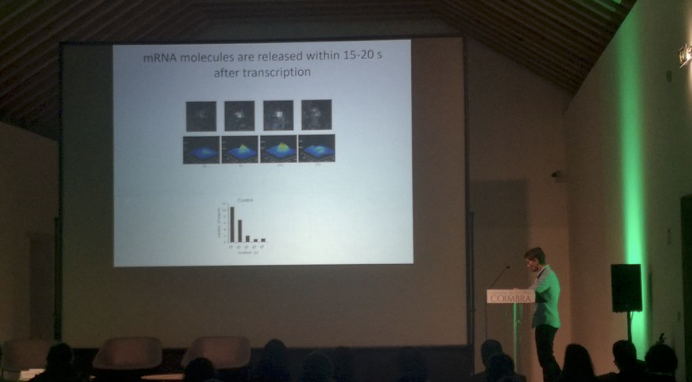
Credits: Nuno Moreno
2019 Brokerslink Conference
October 17-18, 2019
“The longivity challenge and its impact in health insurance” – this theme was aboded by Maria-Carmo Fonseca, RiboMed coordinator, and iMM principal researcher, at 2019 Brokerslink Conference.
The Brokerslink conference, held this year at Bordeaux, France, is an opportunity for our partners and affiliates to meet insurance and risk management experts from across the world.


A twist to splicing regulation in haematopoiesis
Maria Carmo-Fonseca
Nature Cell Biology 2023
ABSTRACT: DNMT3A is best known for its de novo DNA methyltransferase activity. But a new study shows that the protein also has a role in RNA splicing during activation of embryonic and haematopoietic stem cells. This introduces a new perspective for approaching diseases associated with DNMT3A mutations.
Sweet splicing
Maria Carmo-Fonseca
Cell 2023
ABSTRACT: Glucose is the main source of energy for cells. In this issue of Cell, a study now shows that glucose has additional non-energetic functions, acting as a biomolecular cue that regulates alternative splicing during epidermal differentiation. As keratinocytes differentiate, glucose associates with RNA-binding protein DDX21 and modulates its interaction properties, which modifies splicing decisions.
Gene architecture directs splicing outcome in separate nuclear spatial regions
Luna Tammer, Ofir Hameiri, Ifat Keydar, Vanessa Rachel Roy, Asaf Ashkenazy-Titelman, Noélia Custódio, Itay Sason, Ronna Shayevitch, Victoria Rodríguez-Vaello, José Rino, Galit Lev Maor, Yodfat Leader, Doha Khair, Erez Lieberman Aiden, Ran Elkon, Manuel Irimia, Roded Sharan, Yaron Shav-Tal, Maria Carmo-Fonseca, Gil Ast
Molecular Cell 2022
ABSTRACT: How the splicing machinery defines exons or introns as the spliced unit has remained a puzzle for 30 years. Here, we demonstrate that peripheral and central regions of the nucleus harbor genes with two distinct exon-intron GC content architectures that differ in the splicing outcome. Genes with low GC content exons, flanked by long introns with lower GC content, are localized in the periphery, and the exons are defined as the spliced unit. Alternative splicing of these genes results in exon skipping. In contrast, the nuclear center contains genes with a high GC content in the exons and short flanking introns. Most splicing of these genes occurs via intron definition, and aberrant splicing leads to intron retention. We demonstrate that the nuclear periphery and center generate different environments for the regulation of alternative splicing and that two sets of splicing factors form discrete regulatory subnetworks for the two gene architectures. Our study connects 3D genome organization and splicing, thus demonstrating that exon and intron definition modes of splicing occur in different nuclear regions.
Pseudouridylation: A new player in co-transcriptional splicing regulation
Rui Sousa-Luís, Maria Carmo-Fonseca
Molecular Cell 2022
ABSTRACT: Martinez et al. (2022) uncovered a novel function for the most abundant modified nucleoside in RNA. The study shows that uridines at splice sites and splicing regulatory motifs in the pre-mRNA may be converted to pseudouridine during transcription and impact splicing decisions.
The alternative lengthening of telomeres mechanism jeopardizes telomere integrity if not properly restricted
Bruno Silva, Rajika Arora and Claus M. Azzalin
Proceedings of the National Academy of Sciences (PNAS) 2022
ABSTRACT: A substantial number of human cancers are telomerase-negative and elongate physiologically damaged telomeres through a break-induced replication (BIR)-based mechanism known as alternative lengthening of telomeres (ALT). We recently demonstrated that inhibiting the transcription of the telomeric long noncoding RNA TERRA suppresses telomere damage and ALT features, indicating that telomere transcription is a main trigger of ALT activity. Here we show that experimentally increased TERRA transcription not only increases ALT features, as expected, but also causes rapid loss of telomeric DNA through a pathway that requires the endonuclease Mus81. Our data indicate that the ALT mechanism can endanger telomere integrity if not properly controlled and point to TERRA transcription as a uniquely versatile target for therapy.
In Vitro Characterization of the Physical Interactions between the Long Noncoding RNA TERRA and the Telomeric Proteins TRF1 and TRF2
Patricia L. Abreu, Yong Woo Lee and Claus M. Azzalin
International Journal of Molecular Sciences 2022
ABSTRACT: RNA-protein interactions drive key cellular pathways such as protein translation, nuclear organization and genome stability maintenance. The human telomeric protein TRF2 binds to the long noncoding RNA TERRA through independent domains, including its N-terminal B domain. We previously demonstrated that TRF2 B domain binding to TERRA supports invasion of TERRA into telomeric double stranded DNA, leading to the formation of telomeric RNA:DNA hybrids. The other telomeric protein TRF1, which also binds to TERRA, suppresses this TRF2-associated activity by preventing TERRA-B domain interactions. Herein, we show that the binding of both TRF1 and TRF2 to TERRA depends on the ability of the latter to form G-quadruplex structures. Moreover, a cluster of arginines within the B domain is largely responsible for its binding to TERRA. On the other side, a patch of glutamates within the N-terminal A domain of TRF1 mainly accounts for the inhibition of TERRA-B domain complex formation. Finally, mouse TRF2 B domain binds to TERRA, similarly to its human counterpart, while mouse TRF1 A domain lacks the inhibitory activity. Our data shed further light on the complex crosstalk between telomeric proteins and RNAs and suggest a lack of functional conservation in mouse.
betAS: intuitive analysis and visualisation of differential alternative splicing using beta distributions (pre-print)
Mariana Ascensao-Ferreira, Nuno Saraiva-Agostinho, Nuno L Barbosa-Morais
bioRxiv 2022
ABSTRACT: Next generation RNA sequencing allows alternative splicing (AS) quantification with unprecedented resolution, with the relative inclusion of an alternative sequence in transcripts being commonly quantified by the proportion of reads supporting it as percent spliced-in (PSI). However, PSI values alone do not incorporate information about their precision, proportional to the respective AS events’ read coverage. Beta distributions model proportions and are thus suitable to quantify inclusion levels of alternative sequences, using reads supporting their inclusion and exclusion as surrogates for the two distribution shape parameters. Each such beta distribution has the PSI as mean value and is narrower when the read coverage is higher, facilitating the interpretability of its precision when plotted. We herein introduce a computational pipeline, based on beta distributions accurately modelling PSI values and their precision, to quantitatively and visually compare AS between groups of samples. Our methodology includes a differential splicing significance metric that compromises the magnitude of inter-group differences, the estimation uncertainty in individual samples, and the intra-group variability. To make our approach accessible and intelligible to both non-computational and computational biologists, we developed betAS, an interactive web app and user-friendly R package for visual and intuitive differential splicing analysis from read count data.
voyAGEr: free web interface for the analysis of age-related gene expression alterations in human tissues (pre-print)
Arthur L Schneider, Nuno Saraiva-Agostinho, Nuno L Barbosa-Morais
bioRxiv 2022
ABSTRACT: We herein introduce voyAGEr, an online graphical interface to explore age-related gene expression alterations in 48 human tissues. voyAGEr offers a visualization and statistical toolkit for the finding and functional exploration of sex- and tissue-specific transcriptomic changes with age. In its conception, we developed a novel bioinformatics pipeline leveraging RNA sequencing data, from the GTEx project, for more than 700 individuals.
voyAGEr reveals transcriptomic signatures of the known asynchronous aging between tissues, allowing the observation of tissue-specific age-periods of major transcriptional changes, that likely reflect so-called digital aging, associated with alterations in different biological pathways, cellular composition, and disease conditions.
voyAGEr therefore supports researchers with no expertise in bioinformatics in elaborating, testing and refining their hypotheses on the molecular nature of human aging and its association with pathologies, thereby also assisting in the discovery of novel therapeutic targets. voyAGEr is freely available at https://compbio.imm.medicina.ulisboa.pt/voyAGEr
Epigenetic reprogramming by TET enzymes impacts co-transcriptional R-loops
João C Sabino, Madalena R de Almeida, Patrícia L Abreu, Ana M Ferreira, Paulo Caldas, Marco M Domingues, Nuno C Santos, Claus M Azzalin, Ana Rita Grosso and Sérgio Fernandes de Almeida
eLife 2022
ABSTRACT: DNA oxidation by ten-eleven translocation (TET) family enzymes is essential for epigenetic reprogramming. The conversion of 5-methylcytosine (5mC) into 5-hydroxymethylcytosine (5hmC) initiates developmental and cell-type-specific transcriptional programs through mechanisms that include changes in the chromatin structure. Here, we show that the presence of 5hmC in the transcribed gene promotes the annealing of the nascent RNA to the template DNA strand, leading to the formation of an R-loop. Depletion of TET enzymes reduced global R-loops in the absence of gene expression changes, whereas CRISPR-mediated tethering of TET to an active gene promoted the formation of R-loops. The genome-wide distribution of 5hmC and R-loops shows a positive correlation in mouse and human stem cells and overlap in half of all active genes. Moreover, R-loop resolution leads to differential expression of a subset of genes that are involved in crucial events during stem cell proliferation. Altogether, our data reveal that epigenetic reprogramming via TET activity promotes co-transcriptional R-loop formation, disclosing new mechanisms of gene expression regulation.
TREX1-dependent DNA damage links nuclear rupture to tumor cell invasion
Edgar R. Gomes and Sérgio F. de Almeida
Development Cell 2021
SUMMARY: Loss of nuclear integrity correlates with increased DNA damage in different tissues. In a recent issue of Cell, Nader et al. reveal that nuclear envelope ruptures in dense tissue microenvironments cause TREX1-dependent DNA damage and promote the transition from in situ to invasive carcinomas.
Live-Cell Imaging of Transcriptional Activity at DNA Double-Strand Breaks
Madalena R. de Almeida, Eduardo Gameiro, Sérgio F. de Almeida and Robert M. Martin
JOVE 2021
ABSTRACT: DNA double-strand breaks (DSB) are the most severe type of DNA damage. Despite the catastrophic consequences on genome integrity, it remains so far elusive how DSBs affect transcription. A reason for this was the lack of suitable tools to simultaneously monitor transcription and the induction of a genic DSB with sufficient temporal and spatial resolution. This work describes a set of new reporters that directly visualize transcription in live cells immediately after the induction of a DSB in the DNA template. Bacteriophage RNA stem-loops are employed to monitor the transcription with single-molecule sensitivity. For targetting the DSB to a specific gene region, the reporter genes are engineered to contain a single recognition sequence of the homing endonuclease I-SceI, otherwise absent from the human genome. A single copy of each reporter gene was integrated into the genome of human cell lines. This experimental system allows the detection of single RNA molecules generated by the canonical gene transcription or by DNA break-induced transcription initiation. These reporters provide an unprecedented opportunity for interpreting the reciprocal interactions between transcription and DNA damage and to disclose hitherto unappreciated aspects of DNA break-induced transcription.
TERRA transcription destabilizes telomere integrity to initiate break-induced replication in human ALT cells
Bruno Silva, Rajika Arora, Silvia Bione and Claus M. Azzalin
Nature Communications 2021
ABSTRACT: Alternative Lengthening of Telomeres (ALT) is a Break-Induced Replication (BIR)-based mechanism elongating telomeres in a subset of human cancer cells. While the notion that spontaneous DNA damage at telomeres is required to initiate ALT, the molecular triggers of this physiological telomere instability are largely unknown. We previously proposed that the telomeric long noncoding RNA TERRA may represent one such trigger; however, given the lack of tools to suppress TERRA transcription in cells, our hypothesis remained speculative. We have developed Transcription Activator-Like Effectors able to rapidly inhibit TERRA transcription from multiple chromosome ends in an ALT cell line. TERRA transcription inhibition decreases marks of DNA replication stress and DNA damage at telomeres and impairs ALT activity and telomere length maintenance. We conclude that TERRA transcription actively destabilizes telomere integrity in ALT cells, thereby triggering BIR and promoting telomere elongation. Our data point to TERRA transcription manipulation as a potentially useful target for therapy.
Transcription and splicing dynamics during early Drosophila development
Pedro Prudêncio, Rosina Savisaar, Kenny Rebelo, Rui Gonçalo Martinho, Maria Carmo-Fonseca
RNA 2021
ABSTRACT: Widespread cotranscriptional splicing has been demonstrated from yeast to human. However, most studies to date addressing the kinetics of splicing relative to transcription used either Saccharomyces cerevisiae or metazoan cultured cell lines. Here, we adapted native elongating transcript sequencing technology (NET-seq) to measure cotranscriptional splicing dynamics during the early developmental stages of Drosophila melanogaster embryos. Our results reveal the position of RNA polymerase II (Pol II) when both canonical and recursive splicing occur. We found heterogeneity in splicing dynamics, with some RNAs spliced immediately after intron transcription, whereas for other transcripts no splicing was observed over the first 100 nt of the downstream exon. Introns that show splicing completion before Pol II has reached the end of the downstream exon are necessarily intron-defined. We studied the splicing dynamics of both nascent pre-mRNAs transcribed in the early embryo, which have few and short introns, as well as pre-mRNAs transcribed later in embryonic development, which contain multiple long introns. As expected, we found a relationship between the proportion of spliced reads and intron size. However, intron definition was observed at all intron sizes. We further observed that genes transcribed in the early embryo tend to be isolated in the genome whereas genes transcribed later are often overlapped by a neighboring convergent gene. In isolated genes, transcription termination occurred soon after the polyadenylation site, while in overlapped genes, Pol II persisted associated with the DNA template after cleavage and polyadenylation of the nascent transcript. Taken together, our data unravel novel dynamic features of Pol II transcription and splicing in the developing Drosophila embryo.
The splicing factor XAB2 interacts with ERCC1-XPF and XPG for R-loop processing
Evi Goulielmaki, Maria Tsekrekou, Nikos Batsiotos, Mariana Ascensão-Ferreira, Eleftheria Ledaki, Kalliopi Stratigi, Georgia Chatzinikolaou, Pantelis Topalis, Theodore Kosteas, Janine Altmüller, Jeroen A. Demmers, Nuno L. Barbosa-Morais and George A. Garinis
Nature Communications 2021
ABSTRACT: RNA splicing, transcription and the DNA damage response are intriguingly linked in mammals but the underlying mechanisms remain poorly understood. Using an in vivo biotinylation tagging approach in mice, we show that the splicing factor XAB2 interacts with the core spliceosome and that it binds to spliceosomal U4 and U6 snRNAs and pre-mRNAs in developing livers. XAB2 depletion leads to aberrant intron retention, R-loop formation and DNA damage in cells. Studies in illudin S-treated cells and Csbm/m developing livers reveal that transcription-blocking DNA lesions trigger the release of XAB2 from all RNA targets tested. Immunoprecipitation studies reveal that XAB2 interacts with ERCC1-XPF and XPG endonucleases outside nucleotide excision repair and that the trimeric protein complex binds RNA:DNA hybrids under conditions that favor the formation of R-loops. Thus, XAB2 functionally links the spliceosomal response to DNA damage with R-loop processing with important ramifications for transcription-coupled DNA repair disorders.
Reduced Lamin A/C Does Not Facilitate Cancer Cell Transendothelial Migration but Compromises Lung Metastasis
Francesco Roncato, Ofer Regev, Sara W. Feigelson, Sandeep Kumar Yadav, Lukasz Kaczmarczyk, Nehora Levi, Diana Drago-Garcia, Samuel Ovadia, Marina Kizner, Yoseph Addadi, João C. Sabino, Yossi Ovadya, Sérgio F. de Almeida, Ester Feldmesser, Gabi Gerlitz and Ronen Alon.
Cancers 2021
ABSTRACT: The mechanisms by which the nuclear lamina of tumor cells influences tumor growth and migration are highly disputed. Lamin A and its variant lamin C are key lamina proteins that control nucleus stiffness and chromatin conformation. Downregulation of lamin A/C in two prototypic metastatic lines, B16F10 melanoma and E0771 breast carcinoma, facilitated cell squeezing through rigid pores, and reduced heterochromatin content. Surprisingly, both lamin A/C knockdown cells grew poorly in 3D spheroids within soft agar, and lamin A/C deficient cells derived from spheroids transcribed lower levels of the growth regulator Yap1. Unexpectedly, the transendothelial migration of both cancer cells in vitro and in vivo, through lung capillaries, was not elevated by lamin A/C knockdown and their metastasis in lungs was even dramatically reduced. Our results are the first indication that reduced lamin A/C content in distinct types of highly metastatic cancer cells does not elevate their transendothelial migration (TEM) capacity and diapedesis through lung vessels but can compromise lung metastasis at a post extravasation level.
Allosteric Antagonist Modulation of TRPV2 by Piperlongumine Impairs Glioblastoma Progression
João Conde, Ruth A. Pumroy, Charlotte Baker, Tiago Rodrigues, Ana Guerreiro, Bárbara B. Sousa, Marta C. Marques, Bernardo P. de Almeida, Sohyon Lee, Elvira P. Leites, Daniel Picard, Amrita Samanta, Sandra H. Vaz, Florian Sieglitz, Maike Langini, Marc Remke, Rafael Roque, Tobias Weiss, Michael Weller, Yuhang Liu, Seungil Han, Francisco Corzana, Vanessa A. Morais, Cláudia C. Faria, Tânia Carvalho, Panagis Filippakopoulos, Berend Snijder, Nuno L. Barbosa-Morais, Vera Y. Moiseenkova-Bell, and Gonçalo J. L. Bernardes
ACS Central Science 2021
ABSTRACT: The use of computational tools to identify biological targets of natural products with anticancer properties and unknown modes of action is gaining momentum. We employed self-organizing maps to deconvolute the phenotypic effects of piperlongumine (PL) and establish a link to modulation of the human transient receptor potential vanilloid 2 (hTRPV2) channel. The structure of the PL-bound full-length rat TRPV2 channel was determined by cryo-EM. PL binds to a transient allosteric pocket responsible for a new mode of anticancer activity against glioblastoma (GBM) in which hTRPV2 is overexpressed. Calcium imaging experiments revealed the importance of Arg539 and Thr522 residues on the antagonistic effect of PL and calcium influx modulation of the TRPV2 channel. Downregulation of hTRPV2 reduces sensitivity to PL and decreases ROS production. Analysis of GBM patient samples associates hTRPV2 overexpression with tumor grade, disease progression, and poor prognosis. Extensive tumor abrogation and long term survival was achieved in two murine models of orthotopic GBM by formulating PL in an implantable scaffold/hydrogel for sustained local therapy. Furthermore, in primary tumor samples derived from GBM patients, we observed a selective reduction of malignant cells in response to PL ex vivo. Our results establish a broadly applicable strategy, leveraging data-motivated research hypotheses for the discovery of novel means tackling cancer.
POINT technology illuminates the processing of polymerase-associated intact nascent transcripts
Rui Sousa-Luís, Gwendal Dujardin, Inna Zukher, Hiroshi Kimura, Carika Weldon, Maria Carmo-Fonseca, Nick J. Proudfoot and Takayuki Nojima
Molecular Cell 2021
ABSTRACT: Mammalian chromatin is the site of both RNA polymerase II (Pol II) transcription and coupled RNA processing. However, molecular details of such co-transcriptional mechanisms remain obscure, partly because of technical limitations in purifying authentic nascent transcripts. We present a new approach to characterize nascent RNA, called polymerase intact nascent transcript (POINT) technology. This three-pronged methodology maps nascent RNA 5′ ends (POINT-5), establishes the kinetics of co-transcriptional splicing patterns (POINT-nano), and profiles whole transcription units (POINT-seq). In particular, we show by depletion of the nuclear exonuclease Xrn2 that this activity acts selectively on cleaved 5′ P-RNA at polyadenylation sites. Furthermore, POINT-nano reveals that co-transcriptional splicing either occurs immediately after splice site transcription or is delayed until Pol II transcribes downstream sequences. Finally, we connect RNA cleavage and splicing with either premature or full-length transcript termination. We anticipate that POINT technology will afford full dissection of the complexity of co-transcriptional RNA processing.
Unraveling Targetable Systemic and Cell-Type-Specific Molecular Phenotypes of Alzheimer's and Parkinson's Brains with Digital Cytometry
Marie C. Bordone, Nuno L. Barbosa-Morais
Frontiers in Neuroscience 2020
ABSTRACT: Alzheimer’s disease (AD) and Parkinson’s disease (PD) are the two most common neurodegenerative disorders worldwide, with age being their major risk factor. The increasing worldwide life expectancy, together with the scarcity of available treatment choices, makes it thus pressing to find the molecular basis of AD and PD so that the causing mechanisms can be targeted. To study these mechanisms, gene expression profiles have been compared between diseased and control brain tissues. However, this approach is limited by mRNA expression profiles derived for brain tissues highly reflecting their degeneration in cellular composition but not necessarily disease-related molecular states. We therefore propose to account for cell type composition when comparing transcriptomes of healthy and diseased brain samples, so that the loss of neurons can be decoupled from pathology-associated molecular effects. This approach allowed us to identify genes and pathways putatively altered systemically and in a cell-type-dependent manner in AD and PD brains. Moreover, using chemical perturbagen data, we computationally identified candidate small molecules for specifically targeting the profiled AD/PD-associated molecular alterations. Our approach therefore not only brings new insights into the disease-specific and common molecular etiologies of AD and PD but also, in these realms, foster the discovery of more specific targets for functional and therapeutic exploration.
Interactive Alternative Splicing Analysis of Human Stem Cells Using psichomics
Nuno Saraiva-Agostinho, Nuno L. Barbosa-Morais
Methods in Molecular Biology 2020
ABSTRACT: Alternative splicing (AS) generates functionally distinct transcripts and is involved in multiple cellular processes, including stem cell differentiation. Several epithelial-to-mesenchymal transition-related splicing factors have also been associated with pluripotency. Concomitantly with the interest in studying AS in stem cell biology, the advent of next-generation sequencing of RNA (RNA-seq) has increased the public availability of transcriptomic data and enabled genome-wide AS studies. To facilitate performing such analyses in large publicly available or user-provided transcriptomics datasets, the psichomics R package provides an easy-to-use interface and efficient data visualization tools for AS quantification and integrative analyses of AS and gene expression data.psichomics is employed herein to study AS changes between human stem cells and fibroblasts, based on dimensionality reduction, and median- and variance-based differential AS and gene expression analyses. Putative RNA-binding protein regulators involved in those alterations are then identified based on correlation analyses in large cohorts of human tissue transcriptomes. We identified several alterations, both novel and previously reported, in alternative splicing events and in the expression of their candidate regulators that are associated with stem cell differentiation into fibroblasts.
RNA Splicing Defects in Hypertrophic Cardiomyopathy: Implications for Diagnosis and Therapy
Marta Ribeiro, Marta Furtado, Sandra Martins, Teresa Carvalho and Maria Carmo-Fonseca
International Journal of Molecular Sciences 2020
ABSTRACT: Hypertrophic cardiomyopathy (HCM), the most common inherited heart disease, is predominantly caused by mutations in genes that encode sarcomere-associated proteins. Effective gene-based diagnosis is critical for the accurate clinical management of patients and their family members. However, the introduction of high-throughput DNA sequencing approaches for clinical diagnostics has vastly expanded the number of variants of uncertain significance, leading to many inconclusive results that limit the clinical utility of genetic testing. More recently, developments in RNA analysis have been improving diagnostic outcomes by identifying new variants that interfere with splicing. This review summarizes recent discoveries of RNA mis-splicing in HCM and provides an overview of research that aims to apply the concept of RNA therapeutics to HCM.
Pan-cancer association of a centrosome amplification gene expression signature with genomic alterations and clinical outcome
Bernardo P. de Almeida, André F. Vieira, Joana Paredes, Mónica Bettencourt-Dias, Nuno L. Barbosa-Morais
PLoS Computational Biology 2019
ABSTRACT: Centrosome amplification (CA) is a common feature of human tumours and a promising target for cancer therapy. However, CA’s pan-cancer prevalence, molecular role in tumourigenesis and therapeutic value in the clinical setting are still largely unexplored. Here, we used a transcriptomic signature (CA20) to characterise the landscape of CA-associated gene expression in 9,721 tumours from The Cancer Genome Atlas (TCGA). CA20 is upregulated in cancer and associated with distinct clinical and molecular features of breast cancer, consistently with our experimental CA quantification in patient samples. Moreover, we show that CA20 upregulation is positively associated with genomic instability, alteration of specific chromosomal arms and C>T mutations, and we propose novel molecular players associated with CA in cancer. Finally, high CA20 is associated with poor prognosis and, by integrating drug sensitivity with drug perturbation profiles in cell lines, we identify candidate compounds for selectively targeting cancer cells exhibiting transcriptomic evidence for CA.
psichomics: graphical application for alternative splicing quantification and analysis
Nuno Saraiva-Agostinho, Nuno L. Barbosa-Morais
Nucleic Acids Research 2019
ABSTRACT: Alternative pre-mRNA splicing generates functionally distinct transcripts from the same gene and is involved in the control of multiple cellular processes, with its dysregulation being associated with a variety of pathologies. The advent of next-generation sequencing has enabled global studies of alternative splicing in different physiological and disease contexts. However, current bioinformatics tools for alternative splicing analysis from RNA-seq data are not user-friendly, disregard available exon-exon junction quantification or have limited downstream analysis features. To overcome such limitations, we have developed psichomics, an R package with an intuitive graphical interface for alternative splicing quantification and downstream dimensionality reduction, differential splicing and gene expression and survival analyses based on The Cancer Genome Atlas, the Genotype-Tissue Expression project, the Sequence Read Archive project and user-provided data. These integrative analyses can also incorporate clinical and molecular sample-associated features. We successfully used psichomics in a laptop to reveal alternative splicing signatures specific to stage I breast cancer and associated novel putative prognostic factors.
Single-molecule imaging of transcription at damaged chromatin
Alexandra C. Vítor, Sreerama C. Sridhara, João C. Sabino, Ana I. Afonso, Ana R. Grosso, Robert M. Martin, Sérgio F. De Almeida
Science Advances 2019
ABSTRACT: How DNA double-strand breaks (DSBs) affect ongoing transcription remains elusive due to the lack of single-molecule resolution tools directly measuring transcription dynamics upon DNA damage. Here, we established new reporter systems that allow the visualization of individual nascent RNAs with high temporal and spatial resolution upon the controlled induction of a single DSB at two distinct chromatin locations: a promoter-proximal (PROP) region downstream the transcription start site and a region within an internal exon (EX2). Induction of a DSB resulted in a rapid suppression of preexisting transcription initiation regardless of the genomic location. However, while transcription was irreversibly suppressed upon a PROP DSB, damage at the EX2 region drove the formation of promoter-like nucleosome-depleted regions and transcription recovery. Two-color labeling of transcripts at sequences flanking the EX2 lesion revealed bidirectional break-induced transcription initiation. Transcriptome analysis further showed pervasive bidirectional transcription at endogenous intragenic DSBs. Our data provide a novel framework for interpreting the reciprocal interactions between transcription and DNA damage at distinct chromatin regions.
ALTernative Functions for Human FANCM at Telomeres
Beatriz Domingues-Silva, Bruno Silva, Claus M Azzalin
Frontiers in Molecular Biosciences 2019
ABSTRACT: The human FANCM ATPase/translocase is involved in various cellular pathways including DNA damage repair, replication fork remodeling and R-loop resolution. Recently, reports from three independent laboratories have disclosed a previously unappreciated role for FANCM in telomerase-negative human cancer cells that maintain their telomeres through the Alternative Lengthening of Telomeres (ALT) pathway. In ALT cells, FANCM limits telomeric replication stress and damage, and, in turn, ALT activity by suppressing accumulation of telomeric R-loops and by regulating the action of the BLM helicase. As a consequence, FANCM inactivation leads to exaggerated ALT activity and ultimately cell death. The studies reviewed here not only unveil a novel function for human FANCM, but also point to this enzyme as a promising target for anti-ALT cancer therapy.
FANCM limits ALT activity by restricting telomeric replication stress induced by deregulated BLM and R-loops
Bruno Silva, Richard Pentz, Ana Margarida Figueira, Rajika Arora, Yong Woo Lee, Charlotte Hodson, Harry Wischnewski, Andrew J. Deans, Claus M. Azzalin
Nature Communications 2019
ABSTRACT: Telomerase negative immortal cancer cells elongate telomeres through the Alternative Lengthening of Telomeres (ALT) pathway. While sustained telomeric replicative stress is required to maintain ALT, it might also lead to cell death when excessive. Here, we show that the ATPase/translocase activity of FANCM keeps telomeric replicative stress in check specifically in ALT cells. When FANCM is depleted in ALT cells, telomeres become dysfunctional, and cells stop proliferating and die. FANCM depletion also increases ALT-associated marks and de novo synthesis of telomeric DNA. Depletion of the BLM helicase reduces the telomeric replication stress and cell proliferation defects induced by FANCM inactivation. Finally, FANCM unwinds telomeric R-loops in vitro and suppresses their accumulation in cells. Overexpression of RNaseH1 completely abolishes the replication stress remaining in cells codepleted for FANCM and BLM. Thus, FANCM allows controlled ALT activity and ALT cell proliferation by limiting the toxicity of uncontrolled BLM and telomeric R-loops.
RNA Polymerase II phosphorylated on CTD Serine 5 interacts with the spliceosome during co-transcriptional splicing
Takayuki Nojima, Kenny Rebelo, Tomás Gomes, Ana Rita Grosso, Nicholas J Proudfoot, Maria Carmo-Fonseca
Molecular Cell 2018
ABSTRACT: The highly intronic nature of protein coding genes in mammals necessitates a co-transcriptional splicing mechanism as revealed by mNET-seq analysis. Immunoprecipitation of MNase-digested chromatin with antibodies against RNA polymerase II (Pol II) shows that active spliceosomes (both snRNA and proteins) are complexed to Pol II S5P CTD during elongation and co-transcriptional splicing. Notably, elongating Pol II-spliceosome complexes form strong interactions with nascent transcripts, resulting in footprints of approximately 60 nucleotides. Also, splicing intermediates formed by cleavage at the 5' splice site are associated with nearly all spliced exons. These spliceosome-bound intermediates are frequently ligated to upstream exons, implying a sequential, constitutive, and U12-dependent splicing process. Finally, lack of detectable spliced products connected to the Pol II active site in human HeLa or murine lymphoid cells suggests that splicing does not occur immediately following 3' splice site synthesis. Our results imply that most mammalian splicing requires exon definition for completion.
Silencing of the lncRNA Zeb2-NAT facilitates reprogramming of aged fibroblasts and safegards stem cell pluripotency
Bruno Bernardes de Jesus, Sérgio Pires Marinho, Sara Barros, António Sousa-Franco, Catarina Alves-Vale, Tânia Carvalho, Maria Carmo-Fonseca
Nature Communications 2018
ABSTRACT: Aging imposes a barrier to somatic cell reprogramming through poorly understood mechanisms. Here, we report that fibroblasts from old mice express higher levels of Zeb2, a transcription factor that activates epithelial-to-mesenchymal transition. Synthesis of Zeb2 protein is controlled by a natural antisense transcript named Zeb2-NAT. We show that transfection of adult fibroblasts with specific LNA Gapmers induces a robust downregulation of Zeb2-NAT transcripts and Zeb2 protein and enhances the reprogramming of old fibroblasts into pluripotent cells. We further demonstrate that Zeb2-NAT expression is precociously activated by differentiation stimuli in embryonic stem (ES) cells. By knocking down Zeb2-NAT, we were able to maintain ES cells challenged with commitment signals in the ground state of pluripotency. In conclusion, our study identifies a long noncoding RNA that is overlapping and antisense to the Zeb2 locus as a target for rejuvenation strategies.
TRF1 participates in chromosome end protection by averting TRF2-dependent telomeric R loops
Yong Woo Lee, Rajika Arora, Harry Wischnewski, Claus M. Azzalin
Nature Structural & Molecular Biology 2018
ABSTRACT: The shelterin protein TRF2 assembles protective T loops at chromosome ends by stimulating intramolecular invasion of the telomeric G-rich single-stranded DNA (ssDNA) overhang into the duplex telomeric array. The other shelterin factor, TRF1, is thought to mainly facilitate telomeric dsDNA replication without directly participating in end protection. Here we show that in vitro human TRF2 stimulates invasion of G-rich TERRA-like RNA into telomeric dsDNA, leading to formation of telomeric RNA–DNA hybrids (telR loops). The N-terminal basic domain of TRF2 binds to TERRA-like RNA and enables TRF2 to promote efficient RNA invasion. TRF1, through its N-terminal acidic domain, counteracts TRF2-mediated RNA invasion but not ssDNA invasion. In vivo, when TRF1 is depleted or replaced with a variant lacking the acidic domain, TRF2 induces formation of telR loops, which in turn cause telomere loss. Hence, uncontrolled TRF2 threatens telomere integrity, and TRF1 directly supports end protection by suppressing harmful telR loops.
Introns Protect Eukaryotic Genomes from Transcription-Associated Genetic Instability
Amandine Bonnet, Ana R Grosso, Abdessamad Elkaoutari, Emeline Coleno, Adrien Presle, Sreerama C Sridhara, Guilhem Janbon, Vincent Géli, Sérgio F de Almeida, Benoit Palancade
Molecular Cell 2017
ABSTRACT: Transcription is a source of genetic instability that can notably result from the formation of genotoxic DNA:RNA hybrids, or R-loops, between the nascent mRNA and its template. Here we report an unexpected function for introns in counteracting R-loop accumulation in eukaryotic genomes. Deletion of endogenous introns increases R-loop formation, while insertion of an intron into an intronless gene suppresses R-loop accumulation and its deleterious impact on transcription and recombination in yeast. Recruitment of the spliceosome onto the mRNA, but not splicing per se, is shown to be critical to attenuate R-loop formation and transcription-associated genetic instability. Genome-wide analyses in a number of distant species differing in their intron content, including human, further revealed that intron-containing genes and the intron-richest genomes are best protected against R-loop accumulation and subsequent genetic instability. Our results thereby provide a possible rationale for the conservation of introns throughout the eukaryotic lineage.
Deep intronic mutations and human disease
Rita Vaz-Drago, Noélia Custódio, Maria Carmo-Fonseca
Human Genetics 2017
ABSTRACT: Next-generation sequencing has revolutionized clinical diagnostic testing. Yet, for a substantial proportion of patients, sequence information restricted to exons and exon-intron boundaries fails to identify the genetic cause of the disease. Here we review evidence from mRNA analysis and entire genomic sequencing indicating that pathogenic mutations can occur deep within the introns of over 75 disease-associated genes. Deleterious DNA variants located more than 100 base pairs away from exon-intron junctions most commonly lead to pseudo-exon inclusion due to activation of non-canonical splice sites or changes in splicing regulatory elements. Additionally, deep intronic mutations can disrupt transcription regulatory motifs and non-coding RNA genes. This review aims to highlight the importance of studying variation in deep intronic sequence as a cause of monogenic disorders as well as hereditary cancer syndromes.
Alternative splicing: the pledge, the turn, and the prestige: The key role of alternative splicing in human biological systems
Lina M. Gallego-Paez, Marie C. Bordone, A. C. Leote, Nuno Saraiva-Agostinho, Mariana Ascensão-Ferreira, Nuno L. Barbosa-Morais
Human Genetics 2017
ABSTRACT: Alternative pre-mRNA splicing is a tightly controlled process conducted by the spliceosome, with the assistance of several regulators, resulting in the expression of different transcript isoforms from the same gene and increasing both transcriptome and proteome complexity. The differences between alternative isoforms may be subtle but enough to change the function or localization of the translated proteins. A fine control of the isoform balance is, therefore, needed throughout developmental stages and adult tissues or physiological conditions and it does not come as a surprise that several diseases are caused by its deregulation. In this review, we aim to bring the splicing machinery on stage and raise the curtain on its mechanisms and regulation throughout several systems and tissues of the human body, from neurodevelopment to the interactions with the human microbiome. We discuss, on one hand, the essential role of alternative splicing in assuring tissue function, diversity, and swiftness of response in these systems or tissues, and on the other hand, what goes wrong when its regulatory mechanisms fail. We also focus on the possibilities that splicing modulation therapies open for the future of personalized medicine, along with the leading techniques in this field. The final act of the spliceosome, however, is yet to be fully revealed, as more knowledge is needed regarding the complex regulatory network that coordinates alternative splicing and how its dysfunction leads to disease.
Transcription dynamics prevent RNA-mediated genomic instability through SRPK2-dependent DDX23 phosphorylation
Sreerama Chaitanya Sridhara, Sílvia Carvalho, Ana Rita Grosso, Lina Marcela Gallego-Paez, Maria Carmo-Fonseca, Sérgio Fernandes de Almeida
Cell Reports 2017
ABSTRACT: Genomic instability is frequently caused by nucleic acid structures termed R-loops that are formed during transcription. Despite their harmful potential, mechanisms that sense, signal, and suppress these structures remain elusive. Here, we report that oscillations in transcription dynamics are a major sensor of R-loops. We show that pausing of RNA polymerase II (RNA Pol II) initiates a signaling cascade whereby the serine/arginine protein kinase 2 (SRPK2) phosphorylates the DDX23 helicase, culminating in the suppression of R-loops. We show that in the absence of either SRPK2 or DDX23, accumulation of R-loops leads to massive genomic instability revealed by high levels of DNA double-strand breaks (DSBs). Importantly, we found DDX23 mutations in several cancers and detected homozygous deletions of the entire DDX23 locus in 10 (17%) adenoid cystic carcinoma (ACC) samples. Our results unravel molecular details of a link between transcription dynamics and RNA-mediated genomic instability that may play important roles in cancer development.
Human Cactin interacts with DHX8 and SRRM2 to assure efficient pre-mRNA splicing and sister chromatid cohesion
Isabella M Y Zanini, Charlotte Soneson, Luca E Lorenzi, Claus M Azzalin
Journal of Cell Science 2017
ABSTRACT: Cactins constitute a family of eukaryotic proteins broadly conserved from yeast to human and required for fundamental processes such as cell proliferation, genome stability maintenance, organismal development and immune response. Cactin proteins have been found to associate with the spliceosome in several model organisms, nevertheless their molecular functions await elucidation. Here we show that depletion of human cactin leads to premature sister chromatid separation, genome instability and cell proliferation arrest. Moreover, cactin is essential for efficient splicing of thousands of pre-mRNAs, and incomplete splicing of the pre-mRNA of sororin (also known as CDCA5), a cohesin-associated factor, is largely responsible for the aberrant chromatid separation in cactin-depleted cells. Lastly, cactin physically and functionally interacts with the spliceosome-associated factors DHX8 and SRRM2. We propose that cellular complexes comprising cactin, DHX8 and SRRM2 sustain precise chromosome segregation, genome stability and cell proliferation by allowing faithful splicing of specific pre-mRNAs. Our data point to novel pathways of gene expression regulation dependent on cactin, and provide an explanation for the pleiotropic dysfunctions deriving from cactin inactivation in distant eukaryotes.
TERRA promotes telomerase-mediated telomere elongation in Schizosaccharomyces pombe
Martin Moravec, Harry Wischnewski, Amadou Bah, Yan Hu, Na Liu, Lorenzo Lafranchi, Megan C King, Claus M Azzalin
EMBO Reports 2016
ABSTRACT: Telomerase-mediated telomere elongation provides cell populations with the ability to proliferate indefinitely. Telomerase is capable of recognizing and extending the shortest telomeres in cells; nevertheless, how this mechanism is executed remains unclear. Here, we show that, in the fission yeast Schizosaccharomyces pombe, shortened telomeres are highly transcribed into the evolutionarily conserved long noncoding RNA TERRA A fraction of TERRA produced upon telomere shortening is polyadenylated and largely devoid of telomeric repeats, and furthermore, telomerase physically interacts with this polyadenylated TERRA in vivo We also show that experimentally enhanced transcription of a manipulated telomere promotes its association with telomerase and concomitant elongation. Our data represent the first direct evidence that TERRA stimulates telomerase recruitment and activity at chromosome ends in an organism with human-like telomeres.

C4ncr0 is a podcast that explores different dimensions of cancer, in 40 minutes talks between scientists, physicians, patients and that combines information and testimonials in a simple way.
Each episode is dedicated to a different topic, including: RNA vaccines and cancer, DNA repair mechanisms, cancer as a genetic condition, among others.
In this first season, we will have 12 episodes, released every other Thursday on the main steaming platforms: Spotify, YouTube, Google Podcasts, Apple Podcasts and Castbox.
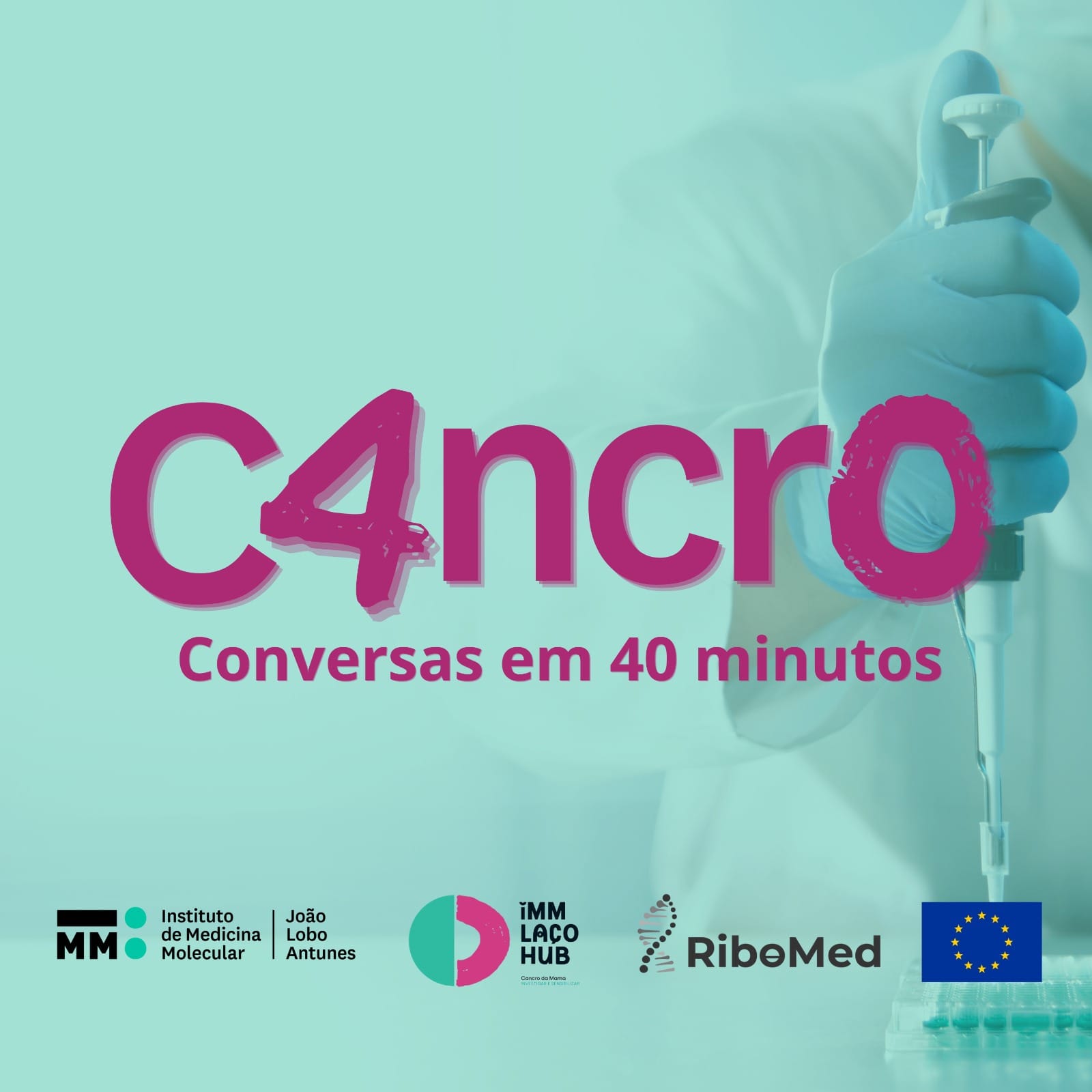 The first episode is called "How is a breast cancer born?" and is a talk between Maria do Carmo Fonseca, President and Group Leader of iMM and Tamara Milagre, President of EVITA, an association that supports carriers of gene alterations related to hereditary cancer.
The first episode is called "How is a breast cancer born?" and is a talk between Maria do Carmo Fonseca, President and Group Leader of iMM and Tamara Milagre, President of EVITA, an association that supports carriers of gene alterations related to hereditary cancer.

The episodes are in Portuguese only.
Here you can find all the news updates about RiboMed project:
Issue #1 | July 2021 - Click here.
Issue # 2 | December 2021 - Click here.
Issue #3 | July 2022 - Click here.
Issue #4 | April 2023 - Click here.
If you want to subscribe the RiboMed newsletter, please fill-in the form (here) and you will receive the newsletter with all the information about RiboMed.



